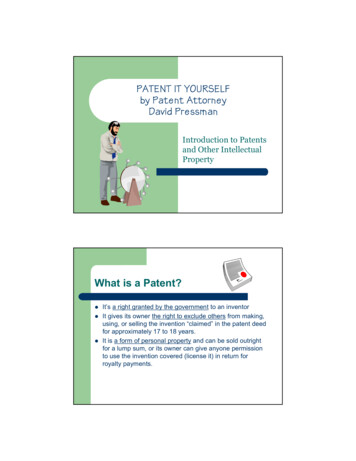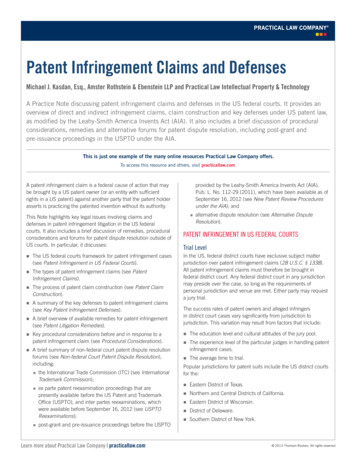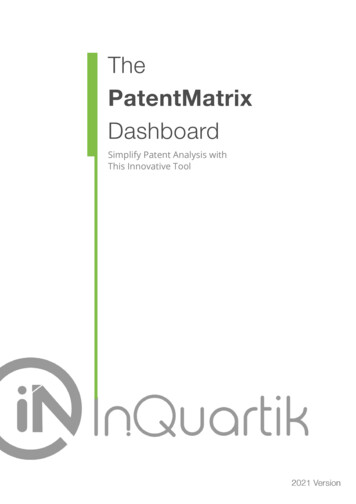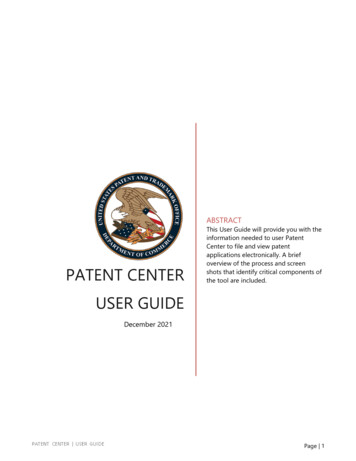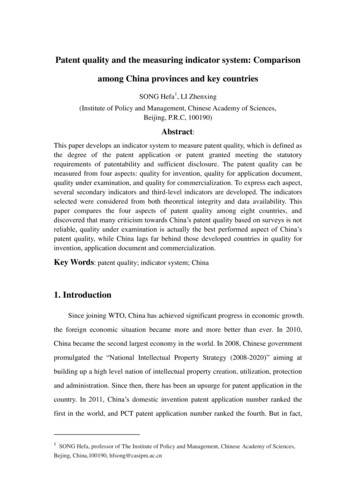
Transcription
Patent quality and the measuring indicator system: Comparisonamong China provinces and key countriesSONG Hefa1, LI Zhenxing(Institute of Policy and Management, Chinese Academy of Sciences,Beijing, P.R.C, 100190)Abstract:This paper develops an indicator system to measure patent quality, which is defined asthe degree of the patent application or patent granted meeting the statutoryrequirements of patentability and sufficient disclosure. The patent quality can bemeasured from four aspects: quality for invention, quality for application document,quality under examination, and quality for commercialization. To express each aspect,several secondary indicators and third-level indicators are developed. The indicatorsselected were considered from both theoretical integrity and data availability. Thispaper compares the four aspects of patent quality among eight countries, anddiscovered that many criticism towards China’s patent quality based on surveys is notreliable, quality under examination is actually the best performed aspect of China’spatent quality, while China lags far behind those developed countries in quality forinvention, application document and commercialization.Key Words: patent quality; indicator system; China1. IntroductionSince joining WTO, China has achieved significant progress in economic growth.the foreign economic situation became more and more better than ever. In 2010,China became the second largest economy in the world. In 2008, Chinese governmentpromulgated the “National Intellectual Property Strategy (2008-2020)” aiming atbuilding up a high level nation of intellectual property creation, utilization, protectionand administration. Since then, there has been an upsurge for patent application in thecountry. In 2011, China’s domestic invention patent application number ranked thefirst in the world, and PCT patent application number ranked the fourth. But in fact,1SONG Hefa, professor of The Institute of Policy and Management, Chinese Academy of Sciences,Bejing, China,100190, hfsong@casipm.ac.cn
China isn’t a strong nation of intellectual property, the overall patent quality is stillvery low. The average effective life span of invention patent is only slightly over 5years. The implementing rate of patents in universities and research institutes is lessthan 10%. The contribution of intellectual property to social-economic development isvery deficient.In recent years, debates around China’s patent quality from abroad have nevervanished. The public seems to believe that China’s patent quality is lower than that ofdeveloped countries. Giacopello (2012) comments that Chinese government policiesare more concerned about promoting patent quantity while seem to have ignoredquality, and technological development of the country was asymmetrical to patentnumbers. Thoma (2013) assesses the quality of Chinese patent applications at EPO,and finds that Chinese applications have shorter renewal life cycles, which indicates alower quality. In a survey of IP professionals by Thomson Reuters and IntellectualAsset Management (IAM) magazine, patent quality of China’s State IntellectualProperty office (SIPO) ranked the last among the world's five largest patent offices.Only 23% and 13% of the surveyed perceive SIPO’s examination quality to be good.A study by OECD, which uses a set of patent indicators as the measurement, showsthat China’s patent quality is under the world average level (Squicciarini andCriscuolo, 2013). What is particularly deserved paying attention to is the report byDan(2012). He points out that China’s IP policies will hamper the nation’s innovation.The goals set by the government tend to focus on number of patent applicationsinstead of on patent quality. The patent subsidy programs only support patentapplications, rather than granted patent and commercialized patents, and thus leadingto a decrease of patent quality. On the other hand, the high cost of rules andprocedures for patent application examination and enforcement of patent right mayalso undermine patent quality.Now, there are twelve patent offices joined the Patent Prosecution Highway PilotProgram including SIPO and the patent examination results can be acknowledged byeach other. It shows that China’s patent system is trusted upon by others (Zhu, 2013).
An empirical study on the grant ratio of applications shows that patent applicationquality didn’t seem to be jeopardized for the enact of those government subsidyprograms, unless the standards for granting a patent were significantly lowered (Li,2012). Facing such many criticism and questions, what is the current status of China’spatent quality? Are Chinese patent applications lagging behind in technology, indocument drafting, or in examination? It is evident that a systematic study is neededto fully answer these questions. However, as argued by Hargreaves (2011), policy onIP issues should be built on the basis of evidence, the situation of China’s patentquality in both domestic and abroad is also needed an investigation based on evidence,instead of feelings or intuitive.This research is attempting to present an evidence-based assessment of China’spatent quality by collecting the interior data from SIPO. The objective of this paper isto establish a measuring indicator system of patent quality and find out the relativeposition of each Chinese province and developed countries that have patents grantedin SIPO. To fulfill this objective, a definition of patent quality is developed firstly.Following that, a quantitative model to measure patent quality is designed based onthe available data. Lastly, the established indicator system and model is applied toboth national and international level comparison.2. The concept of patent qualityThere are three kinds of patent in China which is invention patent, utility modelpatent or industrial design patent. Because the latter two kinds of patent are excludedfrom the scope of “patent” in most countries while invention patent can be generallydefined identically and compared across countries, we choose invention patent as themain subject. In this paper, “patent” refers only to the invention patent, also defined asutility patent in U.S. According to the patent law in most countries, patent refers to thenew product or method which has significant technological progress and outstandingvirtue comparing with the prior art before the application date and shall have novelty,inventiveness or nonobviousness and utility.
Patent quality is defined in various ways. It’s often defined as whether the legalrequirements are properly met, in particular the appropriate subject matter, utility,disclosure, enablement, novelty and nonobviousness (Scotchmer, 2004), or the extentto which a granted patent meets or exceed the statutory standards of patentability,which is novelty, nonobviousness, and the document written clearly and sufficientlydisclosed (Wagner, 2009, Graf, 2007). Furthermore, a high quality patent shall gothrough the Court test without being invalidated (Merges, 1988), and is prosperous toultimately be commercialized and brings social, economic and/or environmentalwelfare (Dan, 2012). Different actors of patent activities may hold different opinionstowards the contents of patent quality. From the perspective of patent users, patentquality is related to factors such as reasonable cost, and manageable patent claims.For patent offices, it is the optimal balance of various dimensions includingperformance, cost, and the service time (Scellato et al., 2011). Patents of high qualityare not inventions that have been widely used but not yet patented; rather, it is trulynew and is implementable by those “skilled in the art”. The validity and breadth ofclaims should be clearly stated with the least uncertainty (Hall and Harhoff, 2004).According to above research, this paper defined the patent quality as the degreeof a patent application or patent granted meeting the statutory requirements ofpatentability, and the degree of its specification meeting requirements of sufficientdisclosure (SONG Hefa, 2010). The definition can be understood in two relatedaspects: One is from patentability. It refers to novelty, inventiveness, and practicalapplicability, which are the universal standards for a patent. The degree of meetingthese standards reflects whether the patent quality is high or low. The other is fromlegal stability and the purpose of patent system, which is a temporary monopoly insacrificing disclosure of technological information to promote further innovation. It isusually the case that sufficiently disclosed patents face less judicial challenges and isless prone to be invalidated. Therefore, sufficient disclosure is a crucial factor in thedefining of patent quality.Based on the definition above, the content of patent quality is divided into three
different but related aspects: technological quality, legal quality and commercialquality. Technological quality is determined by the technical inventiveness of theinvention or the degree of nonobviousness, the technical solution may either solve adifficult problem or generate unexpected technical effect. Technological quality isfundamental to patent quality, which lays the foundation of other aspects of patentquality and mainly decides the market value of the patent. Secondly, legal qualitycontains both how well the application document is written and the quality revealedunder the examination process. It is usually an outcome of interaction between patentattorney and examiners, which reflects whether technical information has beensufficiently disclosed and the claims properly demanded, as well as being supportedby the specification. Patents with higher legal quality are usually more difficult to bechallenged in examination or invalidation procedures. Thirdly, commercial qualityrefers to the commercial value of patents. Though not always, commercial quality isusually proportionate to the overall quality of patents, which is the comprehensiveembodiment of patent quality, even defensive patents are still economically valuable.Therefore, commercial quality is partly dependent on technological and legal quality,and it reflects the other two but relates more with market value.3. Patent quality indicator systemIn order to measure the patent quality, many measuring indicators system havebeen developed. Some scholars use simple indicators to measure the patent quality,such as maintenance rate (Schankerman and Pakes, 1987), number of citations(Henderson et al., 1998), grant ratio, citation to science articles, etc. Other scholarsuse multiple indicators such as an indicator system to measure patent quality. Ernst(2003) proposes the grant rate, citation frequency, size of patent family, technologicaland international scope of patent applications as patent quality indicators. Squicciariniand Criscuolo (2013) suggests that patent scope, family size, backward and forwardcitations, citations to non-patent literature, and claims to be the measurementindicators. Other indicators system include indicators like relative patent position,revealed technology advantage, Herfindahl–Hirschman Index of patents, and patent
citations (Chen and Chang, 2010), forward citations, technological scope, and familysize (Hall et al., 2007), number of patents, citation from patents to scientific papers,technology cycle times, etc. (Hicks et al., 2001). Another stream of research alsofocuses on prosecution quality, where legal security, cost effectiveness, and timelinessare all selected as measuring indicators.The existing research has provided us with many measuring indicator systemsand methods. However, they have three aspects of problems. Firstly, theoreticalstudies are usually good at theoretical integrity, but some of the data is inaccessibleand it is difficult to be put into practical measurement. Secondly, though practicalstudies can take data availability into account, they’re often theoretically deficient andmany of them are measuring examination quality based on prosecution data, whichfail in including all aspects of patent quality. Thirdly, the studies based on survey arehardly comparable across countries and over time.4. The measurement indicator system of patent qualityTo build up a patent quality indicator system, three principles should be adheredto: (1) A proper patent quality indicator system demands rationality in theory and thefeasibility in practice. The most relevant indicators concerning patentability, sufficientdisclosure, and proper patent claims cannot be neglected, and the data for thoseselected indicators should be easily collected. (2) An indicator may bear differentmeanings from different perspectives and should therefore be used carefully. Forexample, a lower rejection rate of applications indicates higher quality of technologyat the macro level, while possibly means a careless examination and hence badexamination quality. However, based on the current study, where all the examinationdata is from Chinese patent office, it is deemed that a lower rejection rate in theexamination stage indicates higher quality of applications. (3) There is no unifiedmeasurement indicator system of patent quality. For enterprises and universities, thefocus is mainly on technological quality, while patent office concentrates more on thequality under examination. For government, commercial quality may be more
important. Therefore, there is hardly an optimal indicator system and it varies by themeasurement purposes and the kind of entities. This paper is intended to evaluate thepatent quality of each Chinese province and make comparison among Chineseprovinces and that of some key developed countries.This paper divides indicator of patent quality into four dimensions formeasurement, including quality of invention, quality of application document, qualityof examination and quality of commercialization, which covers the technological,legal and commercial aspects.4.1 Quality for inventionThe quality of invention is the “objective” quality of a patent. It is primarilyconcerned with patentability, i.e. novelty, inventiveness, and practical utility for atechnology or an invention. Novelty means the invention is not prior art. The degreeof inventiveness or non-obviousness is the core of the patent quality, without whichall other aspects of patent quality shall become ungrounded. An invention patent withhigh quality should solve a desired technical problem, overcome technical bias,achieve unexpected technical performance, or market success.Quality for invention is divided into three secondary indicators: inventive base,extent of meeting statutory requirement, and the technical height of the invention. Toexpress these concepts’ meaning, the paper proposes several third-level indicators asfollows.(1) R&D input per patent application, which stands for inventive base. R&D isalways essential for the creation of a patent. For technologies of higher complexity,adequate financial support is a most basic foundation for creating a better invention.On the macro level, the more input per patent application, the larger potential forcreating better inventions, the better the invention quality tends to be.(2) Grant ratio, which stands for the extent to which statutory requirements aremet. Grant ratio is probably the most commonly used indicator for patent quality. It is
based on the examination procedure, which judges comprehensively on thepatentability of an invention. The higher the grant ratio is, the better the statutoryrequirements are met, and the better invention quality of a region or country isindicated. It is calculated by the proportion of number of the granted patent to the totalnumber of granted patent, rejected application and withdrawal application.(3) Ratio of the proportion of citation times for a region or country in all citationtimes to the proportion of the patent grant number for the region or country in wholepatent granted number. Take a region or country R for example, the indicator for R iscalculated as:cited number of Rgrant number of R cited number of R grant number of RiiThe indicator reflects the invention height. For patent with higher forwardcitations, they are usually critical for technology development or are the basic patentfor industry development. However, the number of citations for a region or country ispositively correlated with the time duration and the number of granted patents. Theforward citation frequency always increases with time but was near zero in recent year.The above indicator can eliminate the influence of number and time. The higher thevalue for this indicator, the better the invention quality tends to be.4.2 Quality for application documentWriting high quality application documents is the second important demand afteran invention is created. Quality for application document is determined by twoaspects: the quality of specification, and the quality of patent claims. To measure thequality for document, this research puts forward following two sub indicators.(1) The average page number of granted patents of specification and attacheddrawing. To disclose technical information sufficiently, so that those ordinarily skilledcan implement the patent without additional creative labor, patents with more numberof pages are prone to be more sufficiently disclosed and more detailed in
implementing cases. According to the data from SIPO, the average page number ofgranted patents for specification and attached drawing of China domestic patent isonly 7, and that of abroad patent is 22.(2) The average number of claims for the granted patent. The essential purposefor filing patent application is to gain monopoly over some technical fields. Therefore,more claim number means more technology solutions are monopolized and moredifficult for others to get re-invented and get patent right around the granted patent.According to the data from SIPO, the average claim number of China domestic patentis 6 and that of the abroad patent is 22.What is needed to be pointed out is thatexcessive claim number will exhaust much more time for the examiner and will leadto a decrease of patent examination quality.4.3 Quality for examinationThe patent examination is a crucial procedure for obtaining patent right, whichcomprehensively appraises whether a patent is patentable or not. In the current study,the quality for examination is to assess the patent quality of each province or countrythat has filed an application in SIPO. The quality for examination is the quality of adrafted application revealed under the examination procedure. It constitutes of twoaspects of indicators: the quality of retrieval and the quality of substantiveexamination. The latter also includes three indicators. One refers to the substantiveexamination itself, and the other two reflects to the examination result in thefollowing procedure of reexamination and invalidation.(1) Average number of referenced X and Y literature per examined patent.Quality of the search report will influence the quality of the examination (de laPotterie, 2011). Since it is required that a granted patent fall out of prior art, thenumber of referenced literature will have a profound effect on patent quality. BecauseX and Y literature are used to appraise the creativity or nonobviousness with one ortwo most related prior arts for an application, if there are more literatures beingreferenced in the examination procedure. Although the quality under examination is
high, the quality of the patent application will be low.(2) Ratio of number of first actions to the total number of patents settled in thesubstantive examination. First actions are the first substantive response from thepatent office telling that the specification or claims have substantive deficiency. Themore first actions issued from the patent office, the less direct granting of patents inthe substantive examination and therefore the lower patent quality is reflected in theexamination stage.(3) Ratio of number of cases in the reexamination stage to cancel originalrejection decisions to the total number of reexamination case settled. After therejection of application in the examination procedure, the applicant is allowed toappeal to the Patent Reexamination Board. If there are more reexamination requeststhat are judged to be reasonable, and hence canceled the original decision to rejectgranting, a better patent quality is revealed under examination stage.(4) Ratio of number of patent whose all or part claims are maintained valid tototal number of invalidation requests of patent. If there are more invalidation requeststhat fail to invalidate the target patents, the patents are hence revealed to be morelegally stable, which indicates that statutory requirements are better met. This is also apositive indicator to patent quality.4.4 Quality of commercializationThe basic assumption of creating patent system is to promote innovation, whichhave two aspects of meanings. One is to get a monopoly of the advanced technologyby disclosing the technical information and then promote innovation. The other is toget economic value which is the core of innovation and finally increase the onsequently,thecommercialization shall not be neglected in the measurement of patent quality. Thequality of commercialization is a comprehensive reflection of the above threedimensions of patent quality. The high quality in invention, document andexamination doesn’t necessarily mean a high performance in commercialization. On
the macro level of regions or countries, the patent quality of commercialization ismore important. People often pay attention to the practical outcome of patent qualityrather than the quality itself. The quality of commercialization has the following threeindicators.(1) Ratio of the number of patent in force to the total number of granted patentsin the past five years. The patent in force is the base for the quality ofcommercialization. To maintain a patent right, companies or other entities need to payfor the annual renewal fee, which is usually increasing according to the “living”length of time. Therefore, with more number of patents in force for a region orcountry, it shows that those patents are still contributing to the economic activities.(2) Ratio of patents that lasts for more than 5 years to all patents in force. This iscalculated by dividing number of patents that lasts for over 5 years by the totalnumber of patents in force. If there are more patents that are maintained for over 5years in a region or a country, it means that among all the living patents, long-lifepatents from this region or country occupy a higher percentage, and hence the patentquality for commercialization is higher.(3) Ratio of royalty and license fee to the number of patents in force for a regionor country. The indicator calculates by the average royalties and license fee per patentin force, which measures the overall quality for commercialization in practicalrevenue. If the average royalty and license fee is higher, the patent quality of theregion or country is also considered to be better. The data can be obtained from theWorld Bank database.4.5 Patent quality index methodAccording the above analysis, the patent quality indicator system the paperproposed is shown in table 1. To get a comprehensive patent quality index, this paperalso puts forward the following calculating equation:F ( X1 X2 X3)mX4n(Equation 1)
Table 1IndicatorQuality forinventionQuality ty forcommercializationSecondary indicatorThird-level indicatorWeight1. Inventive base1. R&D input per patent application0.32. Extent of meetingstatutory requirement2. Grant ratio0.43. Invention height3. Ratio of the proportion of citation timesfor a region in all citation times to theproportion of the patent grant number forthe region in whole grant number0.34. Quality ofspecification4. The average page number of grantedpatents for specification and attacheddrawing0.55. Quality of patentclaims5. The average number of claims forgranted patent0.56. Retrieval quality6. Average number of referenced X and Yliterature per examined patent0.37. Ratio of number of first actions to totalnumber of patents settled in the substantiveexamination0.38. Ratio of number of cases in thereexamination stage to cancel originalrejection decisions to the total number ofreexamination case settled0.29. Ratio of number of invalidation requestswhose whole or part claims are maintainedvalid to total number of invalidationapplications0.210. Ratio of the number of patent in force tothe total number of granted patents in thepast five years0.2511. The ratio of patents that lasts for morethan 5 years to all the patents in force0.2512. Ratio of royalty and license fee to thenumber of patents in force for a region0.57. Quality of substantiveexamination8. Economic base9. Economic valueF stands for the patent quality, X1 stands for the quality for invention, and X2represents the quality for application document, X3 for the quality for examination, X4for quality of commercialization. The underlying rationale for adding up X1, X2, andX3, but multiplied by X4 is based on the relationship between different dimensions of
patent quality. In Equation 1, indicator of X1, X2, and X3 are parallel, but if X4 is lower,the quality will be severely affected. Index of m and n is valued with 0.6 and 0.4according to their elastic coefficient. Coefficients of α、β、γ are contribution rate whichadds up to one (α β γ 1). However, in terms of the value, this paper adoptedunequal value for each impact factor. The rationale is that different aspects of qualityare not equally important. According to the evaluation by experts, quality forinvention is fundamental for better quality patent, and therefore α is assigned 0.35;considering that patent examination is the last stage for issuing a patent, quality underexamination is also valued as 0.35, while the impact factor for document quality is 0.3.Therefore, patent quality is calculated as:F (0.35X1 0.3X2 0.35X3)0.6X40.4To calculate each Xi , several steps are taken: Firstly, for indicators that may havereverse impact on patent quality if exceeding a reasonable limit, for example, pagenumber for specification and the number of claims, the paper sets a maximumbenchmark value. This benchmark value is based on average growth speed of pastthree to five years. Then, each third-level indicator is standardized as:xi * x ijBi max,(i 2011, 2012; j 1 , , 12)Each Xi is calculated based on these standardized third level indicators xi *, usingXi xi *. Different weights are assigned to third-level indicators based on its impacts(See table 1), which is averaged from surveys of several experts. For example, thequality of invention is calculated as:X1 0.3x1* 0.4x2* 0.3x3*5. Results and comparisonSince the study is to assess patent quality among provinces of China and thatamong China and some key countries, most of the data is obtained from SIPO,especially the examination data. The paper also collects data of R&D, royalty and
license fee from the World Bank, and the OECD databases.5.1 China’s patent qualityThe average patent quality score of China in 2011 is 0.257, and 0.254 in 2012,showing a slight decrease. Further investigation reveals that the increase is attributedto the decrease in quality for invention, quality under examination and quality forcommercialization. Only the quality for application document shows a little increase,owing to the rise of document length and number of patent claims. It is shown inFigure 1.Figure 1 China’s patent qualityA comparison of patent quality on the Chinese provincial level is listed as Figure2. It could be seen that in 2012, Shanghai, Hebei, Beijing, Sichuan, and Shanxi are thetop 5 in patent quality. Provinces with huge patent applications such as Jiangsu is nothighly ranked from the perspective of patent quality, which is out of the conventionalknowledge upon Chinese national conditions. Inner Mongolia ranks to be the ninth,which shows that patent quality from provinces with relatively smaller number ofapplications may be very high. The main reason is that those provinces are usuallyunderdeveloped and with fewer reexamination appeals and fewer invalidation cases.
Figure 2 A rank of patent quality on Chinese provincial level(2012)5.2 International comparisonIt is one of the main focuses of this study to clarify on the relative position ofChina’s patent quality. We selected Germany, France, South Korea USA, Japan andItaly, UK as the research countries, and most of them are developed countries whichlocate either in North America, Europe, or Asia.(1) The measurement result shows that for overall patent quality, China ranks thelast. UK has the best performance in patent quality, and is much higher than that of
United States. The reason is probably that UK is significantly better in quality forcommercialization, which helps notably to improve the overall value for patentquality based on our way of calculation. It is shown in Figure 3.Figure 3 Patent Index in 2012(2) A time series comparison shows that patent quality of most of the researchedcountries improved from 2011 to 2012. France is the fastest growing country, whileUK is dropping very fast due to the decrease in quality for commercialization. Chinahas a slight decrease. USA is at the bottom of all the countries with a positive growthrate. The improvement of US patent quality mainly comes from the quality forinvention, quality for document, and a slight increase of quality for commercialization.However, the quality shown in the examination process decreased from 2011 to 2012.
Figure 4 Growth rate of patent quality from 2011 to 2012(3) The quality of examination of China is a little bit better. Based on the data for2012,
(Henderson et al., 1998), grant ratio, citation to science articles, etc. Other scholars use multiple indicators such as an indicator system to measure patent quality. Ernst (2003) proposes the grant rate, citation frequency, size of patent family, technological and international scope of patent applications as patent quality indicators .



